by Scott Simpson
This is the second and final part of a review of Sleepy Hollow Country Club by reader and golf club architecture afficionado Scott Simpson, whom we thank for his interesting and wonderfully written contribution.
Despite some inconsistencies in design features, inevitable given the number of people that have touched the course and the significant changes in routing, Sleepy Hollow is a delightful track, worthy of its reputation and pedigree. The course is characterized by imaginative use of the terrain, some of which would undoubtedly be daunting to a designer, especially one without recourse to modern earth-moving equipment. Most notable is a ridgeline in the midst of the property, along which the 5th, 15th and 16th holes are imaginatively routed.
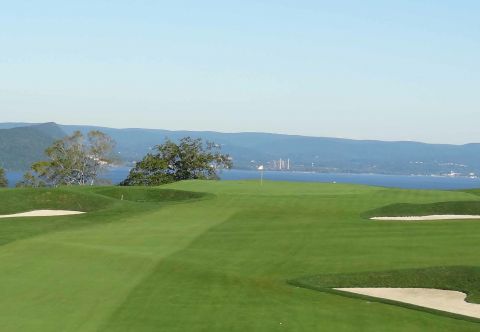
The 5th green appears to be suspended directly above the Hudson River. After an extensive tree removal program, one member is said to have asked his caddy, “When did they put in the river?”
The green complexes at Sleepy Hollow are mostly of the push-up variety (the infinity-style 5th green pictured above is an exception), to be expected since both Macdonald and Tillinghast excelled at building greens slightly elevated from the surrounding landscape. Because of the raised greens, the bunkers remain mostly at fairway level, yet provide a substantial lip to be carried by the player’s explosion shot.
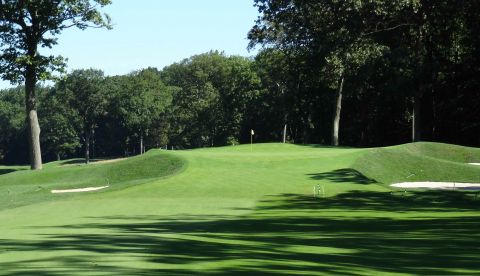
The 11th is typical of the push-up greens found at Sleepy Hollow. Players who miss the green with their approach shots will invariably face a delicate pitch or chip with only the top of the flagstick visible.
The greens themselves were simply spectacular, a tribute to the greens staff. Despite consistent rain in August, including heavy showers the evening before, the greens ran true and fast -- so fast that we all struggled with our speed initially, but greens that a golfer would sell his soul to play on a regular basis. An MGA official told us later that they were running 12.4 on the stimpmeter at the start of play that morning, readings that I hasten to note are by design taken on the flattest terrain.

Anthony adroitly escapes from a greenside bunker on the 11th, one of the deepest on the golf course. While not an issue for a player of Anthony’s skill, the challenge for us mere mortals is obvious.
One minor quibble with the bunkers is that the actual surface of the sand in many cases is quite flat, and balls can frequently end up against or even under a lip of 3 inches or more. When this happens, especially when the ball rests against the back lip of the bunker, the player has absolutely no shot in any direction. Given the raised greens, ensuring that the bunkers play as hazards with sufficient challenge to the recovery shot, I would prefer to see a slight sloping of the bunker, so that balls would feed at least a short distance from the edges.
Macdonald’s use of template holes was designed to ensure that his projects included no weak holes, an admittedly impossible standard. But the strong holes predominate at Sleepy, and we’ll look at some of the best and most interesting amongst them. The 7th hole is Sleepy Hollow’s Redan, though it is technically a reverse Redan and a downhill one at that. Because the downhill shot comes in at a steeper angle (as well as the fact that the shape calls for a fade), the ball will not release on the green as firmly as it does on the original Redan at North Berwick in Scotland. However, the ground leading to the green also slopes severely from the player’s left to right, and Macdonald recognized that players could utilize that landing area to great effect.
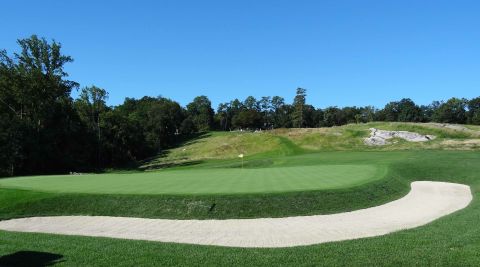
Macdonald’s reverse Redan as seen from behind the green. Despite the flattening effect of the lens, the pronounced slope of the ground short of the green is the ideal landing spot, as the green itself slopes away from the player.
I can’t render a personal verdict on the hole, as my 5-iron sailed long and left, leaving me no viable shot to the green for my second. The downhill nature of the hole certainly lends an air of drama, awaiting the inevitable hard right bounce. My crooked number notwithstanding, I would happily spend an hour on the tee box experimenting with different clubs and shot shapes, searching for that perfect landing spot, but aware that each day would bring different wind and turf conditions and pin placements to which the player must adapt. In that sense we can declare Macdonald successful in adapting the strategic concepts of links golf to an inland setting.
Amusingly, I similarly butchered the original Redan, the 15th at North Berwick, on my only visit to that shrine, though my excuse there was that the hole plays mostly blind. While Redanaphobia is not a widely recognized psychological disorder, my wife Theresa would be well advised to consider a press on the tee when we play the Old Macdonald Redan.
The 10th hole is a similarly dramatic downhill Par 3, especially photogenic with the fronting water hazard and wooden bridge. The golfer instinctively tenses as his ball seemingly takes forever to fall to earth, unsure as to whether the distance has been correctly gauged. Judging from the contours of the green, the drama might not end after landfall. The back of the green, where my well struck 8-iron plugged, is severely sloped. In typically firm conditions, my shot would clearly have spun back towards the center of the green. But, looking at the falloff to the water and the narrow collar of longer grass, it’s unclear whether a shot that lands on that slope remains on the green or even stops short of the water.
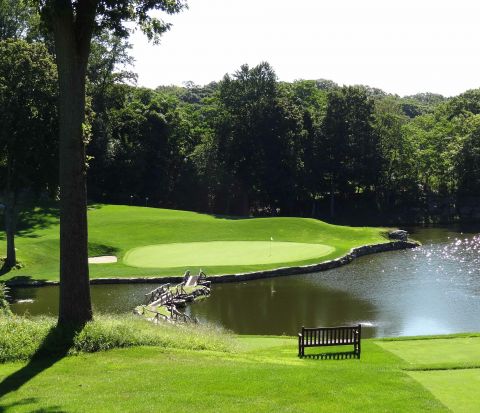
Though not tied architecturally to the remainder of the golf course, the 10th is still an awfully idyllic spot at the far end of the Tillinghast corridor of tree-lined holes. The long walk with a putter must be especially pleasing to club members who have hit the green, as the last segment is over water.
Sleepy Hollow finishes strong, as the routing heads back towards the Hudson and offers up some memorable holes. The 15th is called Punchbowl, the name graphically describing the cylindrical shape of the green and surrounding complex. Any approach shot within the contour of the punchbowl feeds down towards the green, but those left short or offline will produce an interesting third shot, one that can be delicately chipped or pitched or, if the line of play is through the short grass, putted.
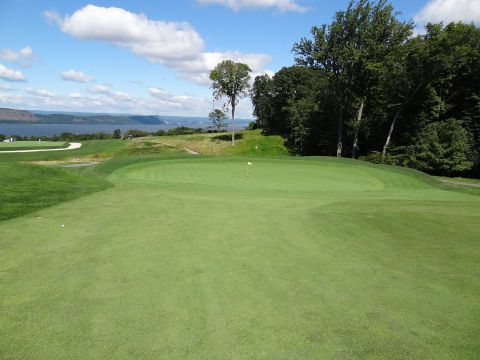
The entrance to the Punchbowl 15th green. Again the camera flattens the perspective, as the slope is at a much steeper pitch than it appears. Mitch wisely putted his ball, visible on the left side of the fairway, and barely had to touch it to run it into the middle of the green, despite extremely soft conditions (in dryer conditions, the approach shot probably feeds onto the green).
We played the hole as a longish Par 4 at 437 yards from the white tees, which was certainly Macdonald’s original intent (and is consistent with the punchbowl template holes at venues such as The National and Seth Raynor’s Yeamans Hall near Charleston, SC). However, an interim renovation of Sleepy Hollow moved the tees back some twenty-five yards and converted the hole into a short Par 5, resulting in most club-players hitting a short, though blind, wedge into the green. The course currently plays as a Par 70, so the temptation to add a third Par 5 is perhaps understandable. But to me (and Macdonald, Raynor, Hanse and Bahto can all be presumed to be in my camp), the challenging longer shot, completely blind except for a directional marker, is the more strategically appropriate, since the challenge of landing a wedge in a punchbowl seems minimal. However, both our newly famous caddy Sean Wolff, a noted good stick per this recent New York Times article and Anthony preferred the 15th as a three-shot hole. I can only attribute this to their skill and length, since even the lengthened hole would effectively play as a long Par 4 for them. They would rarely face the flip wedge into the punchbowl and would obviously relish the legitimate eagle opportunity.
The 16th hole, called Panorama, is a classic Macdonald/Raynor short hole, and by virtue of the Hudson River backdrop, one of the more
A review of photographs of the hole over the years confirms the success of the Hanse/Bahto restoration work. Tillinghast broke up the one bunker into several of his typically large sloping bunkers, presumably retaining the challenge but sacrificing the unique visual effect of his predecessors’ work. But far worse lay in store for this hole, as Rees Jones rebuilt the bunkers into his typically shallow, saucer-shaped hazards. I’ve never understood his bunkering, as the shallow saucers present little challenge to the player and are visually boring. In this instance, he placed two such rounded saucers just short of the green and an elongated saucer in front, resembling a sand-filled emoticon. Fortunately the “Open Doctor’s” design malpractice was mercifully short-lived.
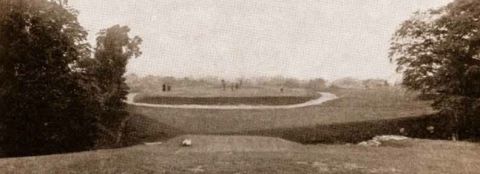
The long and the short of Sleepy Hollow’s short hole. The original Macdonald/Raynor design in 1914 (top). A.W. Tillinghast’s version of the hole, with his typically steeply sloped bunkers, did not improve things (below left). The Reestrocity (below right) made it even worse. (Did players getting up and down from the front bunkers get smileys?)

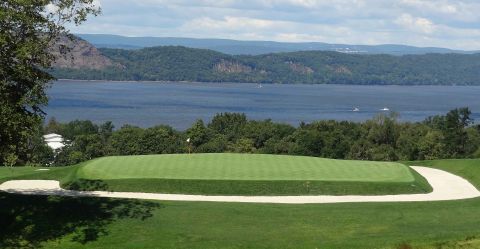
The current 16th (above) restored to its former glory. Below, the view from the front left corner gives only a sense of the contour of the 16th green. My shot spun all the way back from the middle of the green to this low spot, leaving a long uphill birdie putt, though the player will be fortunate to escape with his par.
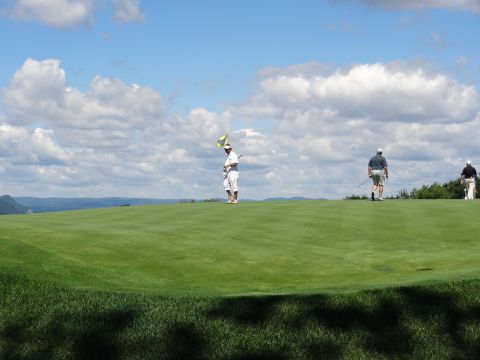
Sleepy Hollow presents an exhilarating challenge for golfers, testing all aspects of their games as they traverse the course’s visually spectacular terrain. Our story also has its own happy ending, as for once the quality of our golf measured up to the venue. Our three amateur partners contributed five natural birdies, which combined with Anthony’s typical firepower, allowed Team Willow Ridge (our club team) to tie for low net in the Pro-Am competition. While we unfortunately didn’t win any money for our professional partner, I’m informed that a beautiful rendering of the 16th hole is being sent to each of the amateurs. I’ll be sure to find a place of honor for it in my home office, as a memory of a delightful day on an exceptional golf course, thankfully restored to its prior glory.



